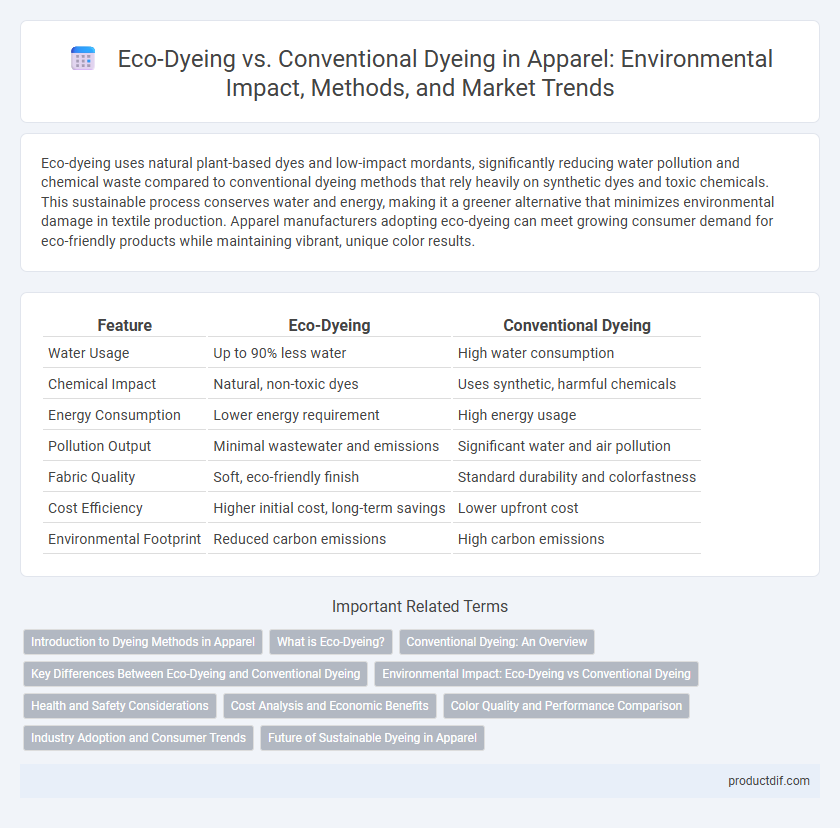Eco-dyeing uses natural plant-based dyes and low-impact mordants, significantly reducing water pollution and chemical waste compared to conventional dyeing methods that rely heavily on synthetic dyes and toxic chemicals. This sustainable process conserves water and energy, making it a greener alternative that minimizes environmental damage in textile production. Apparel manufacturers adopting eco-dyeing can meet growing consumer demand for eco-friendly products while maintaining vibrant, unique color results.
Table of Comparison
| Feature | Eco-Dyeing | Conventional Dyeing |
|---|---|---|
| Water Usage | Up to 90% less water | High water consumption |
| Chemical Impact | Natural, non-toxic dyes | Uses synthetic, harmful chemicals |
| Energy Consumption | Lower energy requirement | High energy usage |
| Pollution Output | Minimal wastewater and emissions | Significant water and air pollution |
| Fabric Quality | Soft, eco-friendly finish | Standard durability and colorfastness |
| Cost Efficiency | Higher initial cost, long-term savings | Lower upfront cost |
| Environmental Footprint | Reduced carbon emissions | High carbon emissions |
Introduction to Dyeing Methods in Apparel
Eco-dyeing in apparel utilizes natural dyes derived from plants, minerals, and other organic sources, significantly reducing the environmental impact compared to conventional dyeing methods that primarily rely on synthetic chemicals and large volumes of water. Conventional dyeing processes often involve pollutants such as heavy metals and toxic effluents, contributing to water contamination and high carbon footprints, whereas eco-dyeing promotes sustainability through biodegradable materials and lower energy consumption. The shift towards eco-dyeing aligns with increasing consumer demand for sustainable fashion and stricter environmental regulations in textile manufacturing.
What is Eco-Dyeing?
Eco-dyeing is a sustainable textile coloring process that uses natural plant-based materials and low-impact mordants, reducing water and chemical consumption compared to conventional dyeing methods. This technique minimizes environmental pollution by avoiding synthetic dyes and toxic effluents typically found in traditional apparel manufacturing. Growing demand for eco-friendly fashion has accelerated the adoption of eco-dyeing to meet consumer preferences and regulatory standards for sustainable apparel production.
Conventional Dyeing: An Overview
Conventional dyeing in apparel manufacturing primarily relies on synthetic dyes and chemical-intensive processes that consume significant amounts of water and energy. This method often involves toxic substances, leading to environmental pollution through wastewater discharge and posing health risks to workers and surrounding communities. Despite its environmental drawbacks, conventional dyeing remains widely used due to its cost-effectiveness, colorfastness, and scalability in mass production.
Key Differences Between Eco-Dyeing and Conventional Dyeing
Eco-dyeing utilizes natural plant-based dyes and minimal water, significantly reducing chemical use and environmental pollution compared to conventional dyeing, which relies heavily on synthetic dyes and large volumes of water. The eco-dyeing process often employs biodegradable mordants and lower energy consumption, enhancing sustainability and reducing carbon footprint. Conventional dyeing, while faster and more vibrant, generates substantial wastewater and toxic effluents that contribute to ecological degradation and pose health risks.
Environmental Impact: Eco-Dyeing vs Conventional Dyeing
Eco-dyeing significantly reduces water consumption and eliminates the use of harmful synthetic chemicals commonly found in conventional dyeing processes, which often contribute to water pollution and soil contamination. Conventional dyeing typically releases toxic effluents containing heavy metals and azo dyes into water bodies, posing severe risks to aquatic ecosystems and human health. Choosing eco-dyeing methods supports sustainable apparel production by minimizing environmental pollution and promoting the use of natural, biodegradable dye materials.
Health and Safety Considerations
Eco-dyeing methods reduce the use of harmful chemicals and minimize exposure to toxic substances, enhancing worker safety and lowering environmental health risks compared to conventional dyeing. Conventional dyeing often involves synthetic dyes and heavy metals that pose significant hazards, including respiratory issues and skin irritations for factory workers. Prioritizing eco-dyeing in apparel manufacturing aligns with stricter health regulations and promotes a safer workplace environment.
Cost Analysis and Economic Benefits
Eco-dyeing significantly reduces water and chemical usage, decreasing overall production costs compared to conventional dyeing, which relies heavily on synthetic dyes and water-intensive processes. Although initial investment in eco-friendly dyeing technology can be higher, long-term savings from lower utility bills, reduced waste management expenses, and compliance with environmental regulations enhance profitability. Brands adopting eco-dyeing also benefit economically from increased market demand for sustainable apparel, driving higher sales and brand loyalty.
Color Quality and Performance Comparison
Eco-dyeing techniques utilize natural plant-based dyes that often result in unique, softer color tones with superior environmental benefits compared to conventional dyeing. Conventional dyeing typically produces vibrant and consistent colors that exhibit higher wash and light fastness, ensuring long-lasting garment performance. However, advancements in eco-dyeing have increasingly improved color retention and durability, narrowing the gap in performance while significantly reducing chemical waste and water consumption.
Industry Adoption and Consumer Trends
Eco-dyeing is gaining traction in the apparel industry due to increasing demand for sustainable and environmentally friendly practices, with major brands integrating it to reduce water usage and chemical waste. Conventional dyeing remains prevalent but faces growing scrutiny over its environmental impact, leading to a gradual shift toward eco-friendly alternatives. Consumer trends favor apparel produced with natural dyes and organic fibers, driving industry investment in eco-dyeing technologies and certifications to meet sustainability expectations.
Future of Sustainable Dyeing in Apparel
Eco-dyeing employs natural plant-based materials and low-impact mordants, significantly reducing water consumption and chemical pollution compared to conventional dyeing, which relies heavily on synthetic dyes and toxic chemicals. Innovations in bio-based dyes and enzyme treatments are accelerating the apparel industry's transition toward more sustainable, eco-friendly dyeing methods. As regulatory pressure and consumer demand for transparency grow, eco-dyeing is poised to become a mainstream solution that minimizes environmental footprint and enhances circularity in textile production.
Eco-Dyeing vs Conventional Dyeing Infographic

 productdif.com
productdif.com